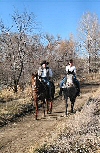Note: This post was written prior to the creation of this blog and as part of an earlier stage in the ongoing public debate over Boulder Open Space and Mountain Parks policies. While somewhat dated, the post still raises important issues which are still relevant.
Let’s not allow political correctness to prevail over objective data regarding Boulder's Open Space and Mountain Parks' (OSMP) Visitor Master Plan. Some extreme preservationists have been decrying “habitat fragmentation due to trails” as if trails were environmental catastrophes and those who enjoy access to public lands ignorant, selfish and destructive. Many scientists, including myself, have also evaluated the data regarding environmental impacts of trails. Our conclusions differ significantly.
No one denies that humans can affect our environment. Let’s assume for a moment that all designated trails on Open Space are 100% environmental sacrifice areas 100’ wide; if so, the total impact on the OSMP ecosystem would be 1.7%. However, objective analysis of diverse data reveals that trails do not fragment habitat. A bird study commissioned by OSMP which set out to demonstrate that trails would create a reduction in species diversity, evenness, and richness compared to control areas, could find no such “trail effect.” The researchers found that the vast majority of birds showed no sensitivity to trails. The probability of a nest occurring near trails was significantly higher than along control transects, and the average probability of nest survival was identical. Another OSMP study along South Boulder Creek found no statistical difference in bird populations regardless of levels of on-trail or off-trail use. These studies show that the "millions" of Open Space visitors have no measurable net effect on habitat integrity. Colorado elk researchers have found that recreationists would have to actively harass each cow elk in a herd more than ten times a season to achieve any reduction in reproductive success. Colorado State Weed Coordinator studies show that wind, water, wildlife fur, bird scat, and truck tires are each more effective than trail users in spreading weeds. Boulder County reports that some raptor species have increased 1000-2000% in the past decade, despite enormous increases in human populations and trail use even near the birds' preferred habitats. This and other research leads reasonable people to conclude that recreation impacts are vanishingly small. Reasonable people would celebrate our relationship with open space as a success, instead of implying threats that don't exist to support a political agenda. How much recreational access should we forsake (close) to allay fears of possible reductions in habitat when none can be measured? More than 50% of our “open” space is already closed to visitor access, and the OSMP trustees want to close even more. Yet people have been frequenting these places for centuries!
Other jurisdictions joyously promote their open space programs’ benefits to their citizens (fresh air, exercise, appreciation of nature, recreation), while admirably protecting their natural resources. That's all Boulder wants: a Visitor Plan that honestly balances natural resource protection AND passive recreational opportunities. We can have both -- if we insist that Council change the paradigm from fears to benefits.
Suzanne Webel
Boulder
Wednesday, March 16, 2005
Subscribe to:
Post Comments (Atom)









No comments:
Post a Comment